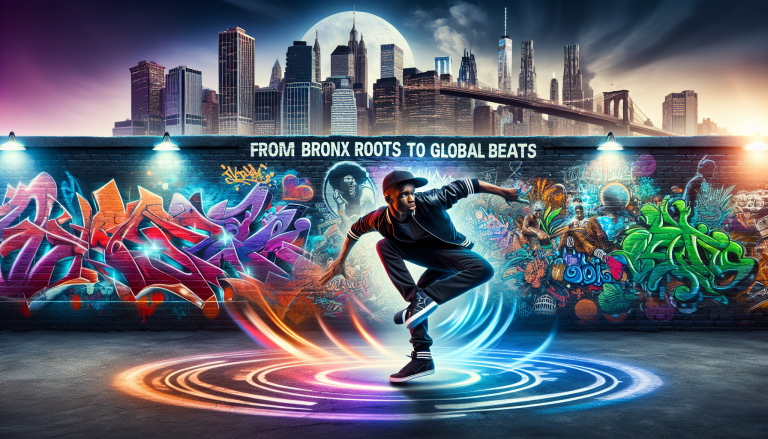From Bronx Block Party to Global Phenomenon: The Vibrant Pulse of Hip-Hop
When the narrative of American music spins its colorful tales, hip-hop emerges not just as a genre, but as a dynamic cultural juggernaut! Born in the gritty, yet creatively charged air of the South Bronx in the 1970s, hip-hop wasn’t just a sound; it was a defiant voice that echoed through forgotten streets. Picture block parties where DJs like Kool Herc tossed breakbeats from vinyl crates, transforming mundane urban chaos into euphoric dance marathons. This was more than music — it was a revolutionary art form birthed from adversity, ingenuity, and a fierce desire to be heard.
The DNA of Hip-Hop: More Than Just Beats and Rhymes

At its core, hip-hop is a richly layered tapestry woven from four essential elements: DJing, MCing (rapping), breakdancing, and graffiti art. This multifaceted culture established a vibrant ecosystem where rhythm met rebellion. The DJ’s role was pivotal, mastering turntables to loop and scratch beats, crafting hypnotic soundscapes that feverishly pumped through park parties and underground clubs alike.
Lyrically, MCs gave this sound a voice infused with sharp wit, storytelling prowess, and social commentary. Rap, as the vocal expression, became the poetry of the streets, blending cadence with keen observations on life, race, politics, and resilience. And let’s not sideline the kinetic artistry of breakdancers—b-boy and b-girl crews spun and popped their way into cultural history, their moves echoing the very heartbeat of hip-hop’s urban origins.
Hip-hop’s sound palette was initially raw and minimalist — boom-bap drums, sampled loops, and spoken word verses — but it always carried an infectious groove perfect for dance floors and street cyphers alike. Through decades of evolution, it absorbed elements from jazz, funk, soul, and even electronic mating calls (hint: that’s where a nuanced link to EDM and dance music appears). This blend propelled hip-hop beyond its American music roots into a worldwide cultural phenomenon.
Heavy Hitters: Architects of Hip-Hop’s Titan Legacy
How do you talk hip-hop without venerating the architects who sculpted its flesh and bones? DJ Kool Herc, widely credited with kickstarting the movement, established the blueprint with his “Merry-Go-Round” technique that looped breakbeats endlessly. Grandmaster Flash revolutionized turntablism by pioneering quick-cut techniques and the crossfader, essentially inventing the DJ’s modern toolkit.
Then came the lyricists — pioneers like Rakim, whose smooth internal rhymes shaped rap’s complexity, or Tupac Shakur, whose poetic fire and raw emotion presented hip-hop’s conscience. The Wu-Tang Clan’s gritty, multifaceted soundscapes opened new artistic dimensions, infusing martial arts philosophy with street hustle narratives.
In recent decades, artists like Kendrick Lamar have catapulted hip-hop into intellectual frontiers, rooted deeply in storytelling with social urgency, proving that hip-hop remains the heartbeat of cultural dialogue. Producers such as Dr. Dre and J Dilla revolutionized production aesthetics, seamlessly intertwining melody, rhythm, and innovation — their beats practically begging your feet to move and your mind to think.
Soundtracks That Shaped a Movement
Certain albums and tracks resonate so profoundly they feel like cornerstones of the genre’s evolution. “Paid in Full” by Eric B. & Rakim remains a textbook classic, pairing slick lyricism with irresistible beats. Run-D.M.C.’s eponymous debut shattered barriers by injecting rock energy into hip-hop, famously collaborating with Aerosmith — a loud declaration that hip-hop was here to stay.
Public Enemy’s “It Takes a Nation of Millions to Hold Us Back” was more than an album; it was an incendiary rallying cry for justice and awareness, its politically charged anthems pulsating with urgency. Fast forward to OutKast’s “Stankonia,” which widened the genre’s sonic universe with futuristic funk and psychedelic soul, proving that hip-hop constantly reinvents itself.
“Illmatic” by Nas is often enshrined as a perfect portrait of New York street life, with every track a narrative gem flowing over jazz-inflected beats. Kendrick Lamar’s “To Pimp a Butterfly” blends hip-hop with jazz, funk, and spoken word—a defiant masterpiece that challenges and uplifts simultaneously.
These albums, and countless beyond them, serve as snapshots of hip-hop’s evolutionary flashpoints, each track a thrilling dialogue between rhythm, social realities, and personal truths.
Hip-Hop’s Everlasting Echo: Culture, Commerce, and Creativity
Hip-hop didn’t just change music—it altered fashion, language, dance, and even commerce. The genre’s lexicon seeped into everyday vernacular, with phrases like “bling” and “flow” becoming universal. The genre injected new life into American music’s middle groove, dramatically influencing EDM and dance music. Producers in dance circles embraced hip-hop’s rhythmic complexity, fostering subgenres like trap EDM, which fused aggressive 808 bass with electronic synths, making festival crowds roar from Miami to Ibiza.
On a cultural trajectory, hip-hop democratized creativity; anyone with a microphone and a message could rise from obscurity to international stardom. It highlighted marginalized voices and spotlighted systemic issues, wielding influence far beyond its block-party origins. The genre’s grassroots attitude encouraged sampling and remixing—core components of EDM’s build-drop-play formula—binding the two scenes in a cyclical relationship of innovation.
From techno and house parties reverberating with hip-hop-infused beats to rap verses floated over synth-driven drops, the synergy between hip-hop and dance music reflects an ongoing creative dialogue. Hip-hop’s bass lines shake dance floors; its lyrical swagger molds the attitude of party culture everywhere.
In the grand tapestry of American music, hip-hop’s vibrant pulse is unmistakable. It embodies resilience and reinvention, bridging generations and genres with unstoppable energy. Whether you’re spitting verses in a cypher, dropping beats behind turntables, or losing yourself on a packed dance floor, hip-hop reminds us that rhythm is life, rebellion is art, and every beat carries a story that deserves to be heard loud, proud, and passionately.